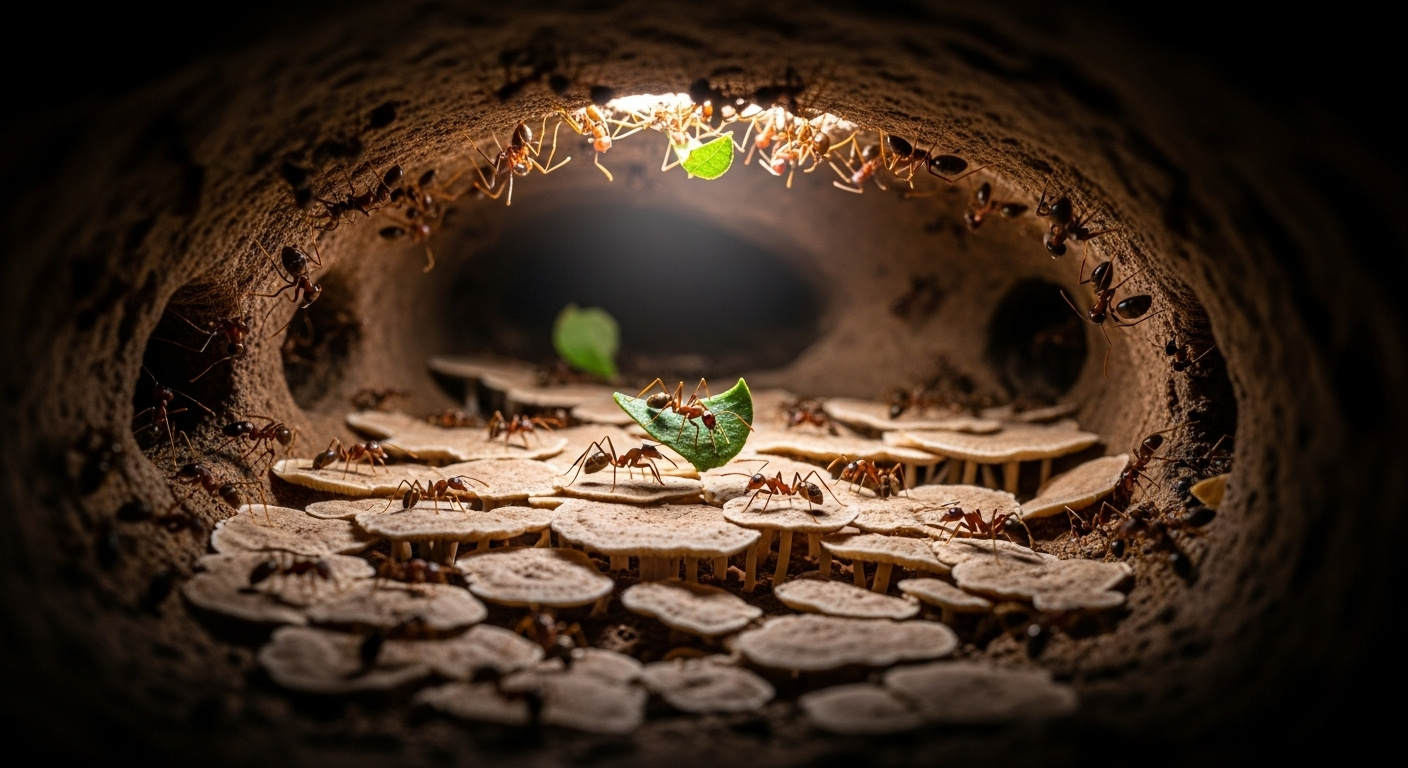The Hidden World of Ant Agriculture
Delve into the fascinating realm of ant agriculture, where tiny farmers cultivate fungi, tend to aphid herds, and manage complex underground ecosystems. This intricate relationship between ants and their living food sources showcases nature's ingenuity and challenges our understanding of agriculture's origins.

The Rise of Fungus-Farming Ants
Approximately 50 million years ago, a group of ants in South America made a groundbreaking discovery that would change their evolutionary trajectory forever. These ants, now known as leafcutter ants, began cultivating fungi in underground chambers, creating the first known agricultural system in the animal kingdom. Today, there are over 250 species of fungus-farming ants, each with its own unique cultivation techniques and fungal varieties.
Leafcutter ants, the most well-known fungus farmers, meticulously cut and transport fresh plant material to their underground gardens. They use this material not as food, but as a substrate for their fungal crops. The ants tend to these fungal gardens with great care, removing any competing fungi or harmful bacteria, and even fertilizing the crops with their own fecal matter. In return, the fungi provide the ants with a nutritious food source that sustains their entire colony.
Aphid Husbandry: Ants as Ranchers
While some ants have mastered agriculture, others have developed a form of animal husbandry. Many ant species have formed mutualistic relationships with aphids, small sap-sucking insects often considered pests by human gardeners. In this relationship, ants act as protectors and caretakers for the aphids, while the aphids provide the ants with a constant supply of honeydew, a sugary liquid they excrete.
Ants have been observed herding aphids to better feeding sites, protecting them from predators, and even bringing aphid eggs into their nests during winter for safekeeping. Some ant species have taken this relationship a step further, selectively breeding aphids to produce more honeydew or to be less mobile, effectively domesticating them. This sophisticated level of animal husbandry demonstrates the ants’ ability to manipulate other species for their benefit, a trait long thought to be unique to humans.
Underground Greenhouses: Climate Control in Ant Farms
One of the most impressive aspects of ant agriculture is their ability to create and maintain ideal growing conditions for their crops. Fungus-farming ants, in particular, have developed intricate systems to regulate temperature, humidity, and air circulation within their underground chambers. These chambers essentially function as greenhouses, providing optimal conditions for fungal growth.
Ants achieve this level of climate control through a combination of architectural design and active management. They construct their nests with specific chamber sizes and tunnel systems that facilitate air flow and temperature regulation. Some species even create ventilation shafts to manage humidity levels. The ants themselves also play an active role in maintaining these conditions, moving their fungal crops to different chambers as needed and adjusting the moisture levels by adding or removing water.
Chemical Warfare in the Ant Garden
Maintaining a healthy crop in the face of pests and diseases is a challenge for any farmer, and ants are no exception. However, these tiny agriculturists have developed an impressive arsenal of chemical defenses to protect their crops. Many fungus-farming ant species produce antimicrobial compounds that they use to combat harmful microorganisms that could threaten their fungal gardens.
Research has shown that some of these ant-produced antibiotics are effective against a wide range of pathogens, including some that affect human crops. This has led to increased interest in studying ant agriculture as a potential source of new antibiotics for human use. The ants’ ability to maintain disease-free monocultures over millions of years is a testament to the effectiveness of their chemical defenses and could provide valuable insights for human agricultural practices.
Lessons from Ant Agriculture
As we face growing challenges in global food production and sustainability, the world of ant agriculture offers valuable lessons and potential solutions. The ants’ success in maintaining sustainable, pesticide-free farming systems for millions of years stands in stark contrast to the environmental issues plaguing modern human agriculture.
One key lesson lies in the ants’ approach to pest management. Rather than relying on harmful chemical pesticides, ants use a combination of biological control methods and natural antibiotics to protect their crops. This integrated pest management approach could inspire more sustainable practices in human agriculture.
Furthermore, the symbiotic relationships that ants have developed with their fungal crops and aphid herds demonstrate the potential benefits of working with nature rather than against it. By fostering mutually beneficial relationships between different species, ants have created resilient and efficient food production systems that have stood the test of time.
In conclusion, the hidden world of ant agriculture offers a fascinating glimpse into nature’s ingenuity and resilience. From fungus farming to aphid husbandry, ants have developed sophisticated agricultural techniques that rival our own in complexity and efficiency. As we continue to unravel the secrets of these tiny farmers, we may find innovative solutions to some of the most pressing challenges facing human agriculture today. The study of ant agriculture not only enriches our understanding of the natural world but also holds the potential to revolutionize our approach to sustainable food production.





